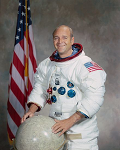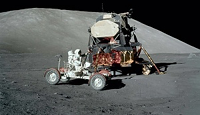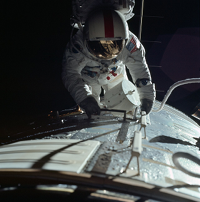Ron Evans was a naval pilot, engineer, and astronaut. He flew the Command Module for Apollo 17, the last mission to land people on the Moon. 
He was born on Nov. 10, 1933, in St Francis, Kan. The family moved, and young Ron graduated from High Park High School in Topeka, Kan., in 1951. He attended the University of Kansas, graduating in 1956 with a bachelor of science degree in electrical engineering. He transitioned to the U.S. Naval Postgraduate School and earned his master's in aeronautical engineering from that school in 1964. In between degrees, Evans completed flight training and received his aviator wings. He served as a fighter pilot aboard aircraft carriers in the mid-1960s, flying more than 100 combat missions during the Vietnam War. In all, he had 5,100 hours of flying time. Selected as an astronaut by the National Aeronautics and Space Administration (NASA) in 1966, he was on the support crew for Apollo 7 and Apollo 11 and was the backup Command Module Pilot for Apollo 14. He was the Command Module Pilot for Apollo 17, the last mission to land people on the Moon. Launch date was Dec. 7, 1972. The trip to the Moon was uneventful. The Lunar Module landed in the Taurus-Littrow valley, somewhere no previous crew had been. Cernan was the first to set foot on the surface; Schmitt followed. Evans, meanwhile, circled above, in the Command Module, mapping the lunar surface and running experiments of his own. He set the record for the longest lunar orbit, at 147 hours and 48 minutes. 
As before, the lunar surface crew took samples of lunar dust and rocks. They also set up scientific instruments. Cernan and Schmitt collected numerous samples of lunar rock and dust, including a rock sample that has many in NASA convinced that the Moon once had an active magnetic field. 
The astronauts performed three EVAs in all. When it was time to leave, they reversed their order; thus, Cernan was the last to walk on the Moon. Their rendezvous with Evans in the Command Module proceeded without incident, as did the return to Earth, during which Evans performed a 66-minute EVA to retrieve film from an exterior camera. His first words during the EVA were "Hot diggety dog!" Splashdown occurred on December 19. The aircraft carrier that was there to pick them up, the USS Ticonderoga was the ship aboard which Evans had served during the Vietnam War. Evans stayed at NASA, serving as backup Command Module Pilot for the Apollo-Soyuz Test Project, in 1975, and then helping in the development of the Space Shuttle program. He retired from the Navy the following year, achieving the rank of captain. In 1977, he let NASA and entered the private sector, working in the coal industry. Evans died on April 7, 1990, of a heart attack in Scottsdale, Ariz. He was 56. He had married. His wife's name was Jan. They have two children. |
|
Social Studies for Kids
copyright 2002–2026
David White




